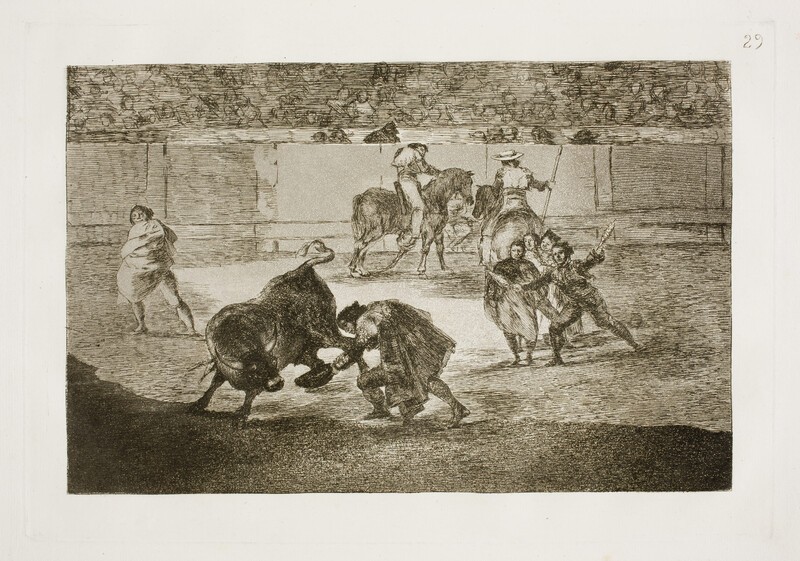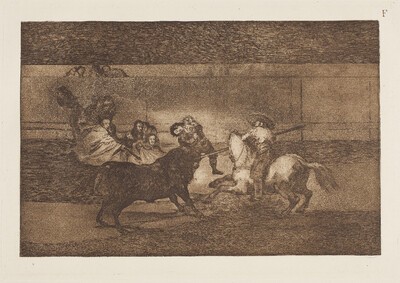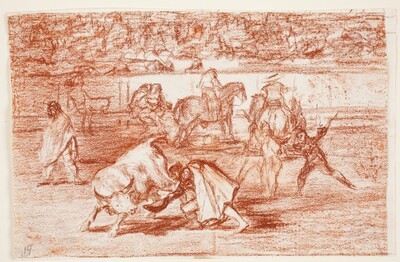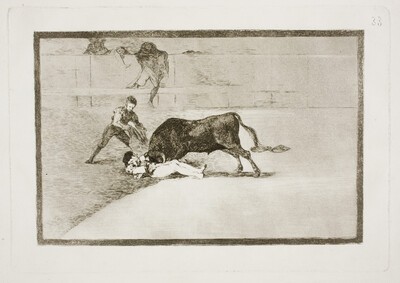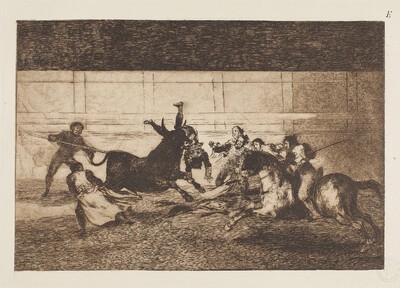- Cronología
- Ca. 1810 - 1815
- Dimensiones
- 248 x 356 mm
- Técnica y soporte
- Aguafuerte, aguatinta, punta seca, buril y bruñidor
- Reconocimiento de la autoría de Goya
- Documented work
- Ficha: realización/revisión
- 03 Oct 2021 / 22 Jun 2023
- Inventario
- 225
- Otros títulos:
-
29 (print, upper right-hand corner)
See How the ancient Spaniards hunted bulls on horseback in the countryside
Three state proofs of this print have survived: the first before the additional aquatint and burin were applied; the second before the aquatint was burnished; and the third before the aquatint was fully burnished.
The plate is kept at the National Chalcography (nº 362).
See How the ancient Spaniards hunted bulls on horseback in the countryside
This is the first of the four scenes of Bullfighting (Nos. 29 and 33) and their extensions (E and F) dedicated to another well-known bullfighter of the time, considered a real star in his lifetime, José Delgado Guerra, better known as Pepe Illo (Pepe-Hillo). Born in Seville in 1754, he was a disciple of the famous Costillares and one of the undisputed glories of bullfighting in Goya's time, having received his alternative in Malaga in 1774. His bullfighting was full of joy and sensuality, unlike that of his great rival, the famous Pedro Romero, Goya's favourite, who was much more reserved.
In this print we can see how the famous Sevillian bullfighter, after sticking a pair of sticks into the bull, separates from it and seems to be giving it a "remove" as a gesture of farewell with his hat in his hand, his head bowed and his body slightly bent, while the bull looks at him with a hard gesture, as if enraged. In a secondary shot we see a bullfighter on the right, together with a number of farmhands, ready to stick another pair of sticks into the bull. Further back, two bullfighters are seen retreating with their horses, the one on the left seriously injured, no doubt gored by one of the bulls, as his intestines are hanging out and he is dragging them along the ground. Such dramatic events, very surprising to today's eyes, were commonplace in Goya's time because the horses had no protection against goring, and it could almost be said that they were part of the spectacle that the public expected to see when they paid for their tickets.
Beruete considers that this is a blackened etching and that Goya may have worked hard but did not achieve the desired result. Nevertheless, the contrasting chiaroscuro effects are used effectively to highlight the central area of the composition. Lafuente Ferrari, for his part, comments on the differences between the print and his preparatory drawing.
Martínez-Novillo emphasises the plasticity of the scene and points out that the picador's horse in the centre background is being gutted to death, which adds to the drama of the representation. Bagüés, for his part, focuses on commenting on the type of ornate bullfighting performed by the bullfighter, who belonged to the so-called Sevillian school, which Goya insisted on depicting despite his preference for Pedro Romero's way of bullfighting.However, the Aragonese painter depicted Pepe Illo performing an action, the defiant salute to the bull, which revealed his recklessness.
There is a preparatory drawing for the present print, also entitled Pepe Illo making the trimming to the bull
-
Grabados y dibujos de Goya en la Biblioteca NacionalBiblioteca NacionalMadrid1946catalogue Elena Páez Ríos
-
Goya en la Biblioteca Nacional. Exposición de grabados y dibujos en el sesquicentenario de su muerteBiblioteca NacionalMadrid1978May - June 1978
-
Grabados de Goya: colección propiedad de la Biblioteca Nacional, que se conserva en su Gabinete deCasa de la Amistad de MoscúMoscow1979exhibition displayed from January 18th to 31st 1979
-
1984
-
Madrid1987
-
Madrid1990
-
Goya grabadorFundación Juan MarchMadrid1994consultant editors Alfonso E. Pérez Sánchez and Julián Gállego, from January 14th to March 20th 1994
-
Goya grabadorMuseo del Grabado Español ContemporáneoMarbella1996from March 8th to May 5th 1996
-
Zaragoza1996
-
Schlaf der Vernunft. Original radierungen von Francisco de GoyaMunich2000
-
Madrid2002
-
Madrid2002
-
Bilbao2012
-
Zaragoza2017
-
MadridBlass S.A.1918p. 136
-
ZaragozaTip. del Hospicio1926pp. 35-36
-
1946pp. 177-216, espec. p. 204
-
BarcelonaTartessos-F. Oliver Branchfelt1946 (reed. 1951)
-
1961pp. 120-127
-
OxfordBruno Cassirer1964vol. II, 1964, p. 345, cat. 232
-
Vie et ouvre de Francisco de GoyaParísOffice du livre1970p. 279, cat. 1208
-
MilwakeeMilwaukee Art Museum1986pp. 26 y 32
-
Goya, toros y torerosMadridMinisterio de Cultura, Comunidad de Madrid1990p. 112, cat. 45
-
MadridCaser-Turner1992pp. 36-37
-
Catálogo de las estampas de Goya en la Biblioteca NacionalMadridMinisterio de Educación y Cultura, Biblioteca Nacional1996cat. 354
-
MadridMuseo Nacional del Prado2001pp. 90-91
-
Goya. In the Norton Simon MuseumPasadenaNorton Simon Museum2016pp. 186-201
